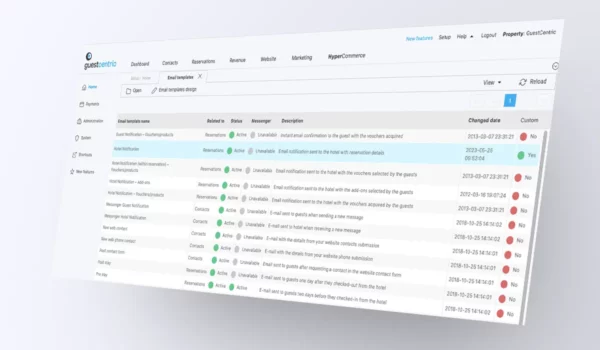Travel Disruptions in 2022 – What can Hotels learn?
Reading Time: 5 minutesFollowing just over two and a half years of restricted travel, consumer demand has resumed with a vengeance in summer 2022. But as thousands travel this summer, the headlines have been dominated by woeful tales of cancellations, queues and costly delays.
To help us unravel this issue, we sat down with Aviation expert, Gavin Eccles, who shared some insights about the current challenges commercial airlines face today and the important lessons the wider travel and hospitality industry should learn from them.
How did Commercial Airlines get to Where we are Today?
At the start of 2020, following widespread lockdowns and travel cancellations, a significant number of aircraft were placed in storage and some were scrapped altogether. In addition, most airline staff were put into furlough or, in the case of pilots, entered early retirement. With only a small number of aircraft and crew, airlines did what they could to survive the downturn.
As vaccination levels increased and restrictions eased on a global scale, by summer 2022, airlines made sure there was capacity to accommodate extremely high levels of pent-up travel demand. “Airlines pulled aircraft out of storage and threw summer 2019 schedules into the system,” says Gavin. “The mindset was to repeat summer 2019 travel levels, but with around 5% less aircraft and minus China,” he continues.
But although airlines responded to the pent-up demand by significantly increasing capacity and prices, pinpoints one crucial detail that was overlooked, “Airlines and their network teams were not so aligned with Human Resources and were not so communicative with airports for that matter. They didn’t define the state of employees, who was ready to get back into work, and what level of training was required. Airlines over planned with capacity, but not human resources, and that is where they hit the hurdle.”
Unlike with hotels, restaurants, and other hospitality and travel businesses, the airline industry is heavily regulated. “It takes at least a month for airlines to screen candidates and issue clearance. In the case of pilots, major airlines can re-train around 20 on average through the systems per month. Training new employees and even re-training returning staff is a regulated, lengthy, expensive process.” Gavin adds. “Airline staff actually want to return to work, but are delayed by regulation and training requirements, all of which are there to passengers’ safety – but they should have been considered before summer 2022.”
Rising Covid numbers also continue to have an impact on the workforce. As much as the world has reopened, Covid has not gone away, impacting who can work in airlines. Some countries still make people quarantine when they have Covid.
What are the Top Concerns around Today’s Widespread Flight Disruptions?
Airlines were bullish with capacity and prices in response to record-breaking travel demand in 2022. But with summer well underway, there is growing concern that cancellations may cut into profit margins, as well as the question of what demand will look like during the summer and winter months.
“Although airlines are doing their best to be flexible and consolidate flights to mitigate the impact of the disruptions, there are rules on what markets allow in terms of cancellations,” says Gavin. “Generally, if the airline cancels more than 48 hours before departure, it can provide an alternative flight and the customer accepts it or not. But cancellations made less 48 hours before departure oblige the carrier to provide the passenger with alternative options and, as you can imagine, this is not easy at the moment, adding even further pressure to the carriers.”
Furthermore, with significantly less staff and the same regulations of number of crew members per passenger, there is a significant disparity between demand for flights and operational constraints. “We’ve reached a point where airports must cap the number of passengers per day, which in turn restricts the airlines,” Gavin observes. “We also saw easyJet with a 154-seater Airbus A319 aircraft cap seats; by taking out a few seats, the airline was able to operate with one less crew member. Adapting the situation to heavy regulation versus cancelling the operation for all.”
When asked whether the current travel disruptions will dampen consumer confidence to travel this summer, Gavin replies: “Those who have already booked will likely just ride the wave and hope that they don’t miss flights or that the airline doesn’t cancel. Those who haven’t yet booked may reconsider travel this summer. Pricing has also impacted last minute travel bookings. Prior to the pandemic, there was always the chance of a cheap last-minute deal, but this no longer seems to be the case in summer 2022.”
What Lessons can Airlines and the wider Hospitality & Travel Industry Learn from all this?
Looking at the situation today, Gavin highlights the need for more flexibility to manage the peaks and troughs of travel demand. “In the summer you have major spikes, but airlines need to plan on the basis of just three months out of the year being extremely busy, and find ways to be more flexible with contracts and staff,” he says.
Although effective workforce planning and deployment enables businesses to build a strong talent pipeline to ensure the right number of employees with the right skills are deployed in the right place at the right time, Gavin notes that this concept becomes a lot more challenging in the aviation industry. “It’s not so easy to quickly deploy staff based on the level of demand due to regulations.”
Gavin observes that a temporary workforce and leasing model could be a viable option to tackle these challenges. “In aviation we have what is called ACMI wet-leasing, which is an agreement between two airlines where the lessor agrees to provide an aircraft, crew, maintenance and insurance (ACMI) to the lessee in return for payment on the number of block hours operated. This solution is typically used in cases of emergency and at very short notice, but you could argue that similar contracts could be implemented during a 2 to 3 month period of peak demand,” he says.
But while there may be scope for different airline companies to work together and have temporary workforce and aircraft contracts in place, Gavin acknowledges that there are some issues to iron out before establishing the model. He adds, “Aviation is all about safety and reliability, and branding significantly influences consumers in this regard. This begs the question of whether airlines can just readily lease out aircraft to other companies that may not share their values, and what the impact would be on consumers.”
Airport security measures may also need to be redefined to minimize endless queues and delays. “Some EU destinations are already fast-tracking entries for travelers from selected markets such as the UK, US, and Canada. But not everyone knows this and passports need to be stamped, so delays are still occurring despite these measures,” Gavin adds.
What’s next for Airlines and the Wider Travel Industry?
Gavin also highlights concerns around what business will look like during the autumn and winter periods: “The euphoric level of travel we are seeing now is a peak summer trend that we do not have in September, October, and November. We must also remember that family travel virtually ends when schools reopen.“
The burning questions now are: What will happen when the cost of inflation starts to hit people? They want a holiday now, but will they want it in a couple of months? Will we return to the pre-pandemic standard of two to three holidays per year with major inflation concerns looming?”
Gavin predicts that current prices are unlikely to hold in the lower seasons and airlines may need to rethink their prices in order to retain demand. “ Airlines – and other travel companies from hotels to travel agencies – need to re-evaluate their revenue management strategies and we may see discounts implemented to stimulate demand,” he observes.
Airlines will also need to think about effectively managing their workforce during the low season. Gavin concludes: “We must remember the staff shortage is a peak summer issue.My concern now is that airlines will recruit enough staff now, only to be faced with a different set of problems in the autumn and winter due to low load factors and demand. Airlines that are investing heavily now run the risks of higher costs coupled with lower demand further down the line.”
The key takeaway is that flexibility and foresight are essential to manage the peaks and troughs of travel demand. We’re seeing record-breaking levels of demand now, but airlines must consider what will happen when consumers start to feel the pinch of inflation further down the line.
What are you doing to prepare for the low season?

























